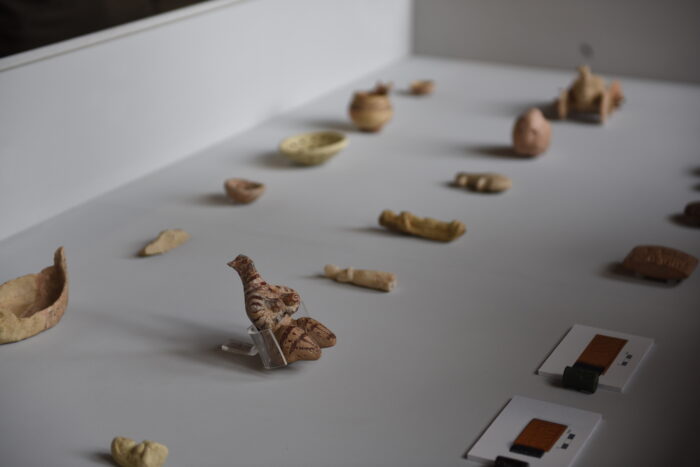Archaic, the Iraq pavilion at the Venice Biennale, was presented by the Ruya Foundation in 2017. The pavilion includes works from eight contemporary artists as well as forty artifacts from the Iraq Museum, which span the last six millennia. The exhibition reflects on the tumultuous history of Iraq, indexing political upheaval and conflict with the inclusion of objects that have now been recovered from the 2003 looting of the museum. Archaic calls to action more protection and restitution of ancient artifacts, but more needs to be done. The pavilion draws attention to the present realities that may also be considered “archaic,” putting the contemporary moment in direct conversation with the past. Here, you can imagine one of these conversations:

Who am I? How quickly you forget… a mother goddess who has lived infinite lifetimes preceding you, and infinite more to come. Neolithic civilization was not that long ago, or was it? Now I am the one who is forgetful. I cannot share with you all of my secrets, because there are some lessons you will have to learn for yourself, but I will get you caught up in my life, while you have been so caught up in your own….
So where to start? How did I end up here? To those of you who could not attend, let me enlighten you, or tell you what you might have missed:
I am long overdue in making a proper introduction, so let’s get to the point. I come from Ancient Mesopotamia, and now, 7000 years later, there are several statuettes that are just like me, still being discovered… in fact, in July of 2020, a sister of mine finally achieved restitution, with many organizations committed to countering unethical practices of obtaining cultural heritage objects. You can find a mother goddess, just like me, in the ICOM Emergency Red List for Syrian Cultural Objects at Risk. So that means, you should be paying attention.
Like the other statuettes, I fit in the palm of your hand, and because of this, I have really seen it all. On April 10, 2003, looters broke into the National Museum of Iraq in Baghdad. Antiquities like me, caught in the conflict zone, were violently displaced from our safe space, left vulnerable and without a sanctuary.
Some have said that “stuff happens…” I urge you to question: why? What does it mean to destroy heritage? What does this say about the state of humanity? Is there any hope?
So let’s talk about Archaic. What does the word, archaic, mean to you? What does it mean to me? Curators Tamara Chalabi and Paolo Colombo of this pavilion have included myself, along with 39 other ancient artifacts, to explore these questions, and discuss their complexities. You can also hear Chalabi talk about this more candidly with Christopher Livesay from NPR. We are positioned to spark a conversation with the new contemporary artwork that is also included.
Here I am, flattered that one of these artists, Sadik Kwaish Alfraji, included a depiction of me in his separate exhibition, About Hunt, About Human. Alfraji continues to explore these dichotomies in Archaic, exploring the human condition and predator-prey dynamic.
Right now, I appear to be the prey. Amongst my fellow artifacts, I am a minority in that I have left Iraq before, but not of my own free will. I was one of the objects recovered from the Netherlands in 2010 via an Interpol directive; I am lucky. Many of these artifacts have yet to be recovered, and circle the market at the mercy of modern capitalist motivations that supersede ethical concerns. The human urge for a voyeuristic display of power. Some things never change, they just take on different shapes.
Archaic calls attention to the violent disruption that so many cultural antiquities are subjected to. This is it. This is what we have left of the past. The years it has taken to piece together this puzzle, to weave the different storylines, can be forgotten in an instant, if these antiquities fall into the wrong hands. I am the closest you will ever get to understanding Mesopotamia. And while I have lived infinite lives, there is a finite number of heritage objects that lend insight into the past. Consider that with so many that go missing, we are all at risk.
You, too. Against all odds, a clay figurine from the Neolithic Age, beats on. Certainly, there is something to be said for my centuries-long kept secrets. Help me ponder what it means to be “archaic.” Do not let me slip into the folds of history, forgotten. To be archaic is to be old, and in some ways, archaic is thought to be obsolete. But I advise you to tread lightly when considering what should and should not be considered, when anything—a way of thinking, a way of engaging, or an object—can be categorized as “archaic.” How do we build a future that incorporates the archaic instead of forgetting it? It is time to reorient and adjust the patterns and behaviors we have put up with for far too long, regarding laws, governing styles, and unethical collection practices. Let us champion restitution! To be forgotten is to be obsolete. To be archaic is to be challenged. Challenge what you know to elicit change.
With love,
Your Mother Goddess
Emma Schaeffer is a junior at Colgate University. She is an Art & Art History major, with a particular interest in both contemporary art, as well as restitution of cultural heritage objects. With inspiration from Laura Godwin’s The Doll People, Emma imagines a narrative from the perspective of the mother goddess figurine.
